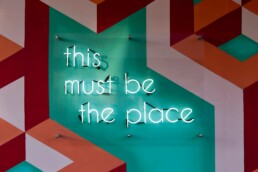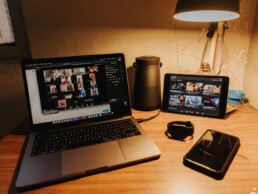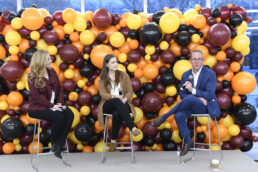Top 6 Tips for Adding Value

Call it a blessing in disguise but, meeting and event planners have gotten to use their creative side when hosting virtual programs. This has mainly come in the form of video conference systems like Zoom, Microsoft Meetings, Skype, and more. While a virtual event seems pretty straight forward, transferring a sponsor’s or attendee’s benefits to a virtual platform is maybe not-so-straight forward. In this article, we are going to give you our best tips for adding value to your stakeholders, a lot of which are from our very own Virtual Planner Master Class. This Master Class brought together some of the brightest minds in meeting and event planning to help discuss these issues and come up with some amazing solutions.Â
- Classes and tutorials: Online classes and tutorials offer great sponsorship opportunities and real value to event attendees. Things like cocktail mixing classes, cooking classes, or craft classes will allow your event to be more relaxed and provide real benefits to participants.Â
- Digital sponsor ad placement: While banners and physical sponsorship apparel may seem longer lasting attendees’ minds, online banners can still make a huge impression during webinars and virtual events. Staying as a static or changing montage of banners, these can bring in more value to sponsors and your event.Â
- Sponsor entertainment breaks: Many more online meetings and events have begun to utilize breaks in order to give attendees a chance to stretch their legs and grab another cup of coffee. During the break, you could host a small concert or another unique form of entertainment that could feature sponsors’ products and services. Or, simply have a screen with sponsor logo exposure that is displayed during the break with background music. This is an easy and fun way to build value around virtual events.Â
- Educational opportunities: A great way to retain sponsorship value in an event is simply by educating attendees through quick company overviews and how they relate to the topic at hand. Tying in a sponsor to your event’s overall theme or mission would allow them to stay even more relevant in the minds of your audience.
- Integrated chat features: Specialized chat room features during, in between, or after presentations can allow your event attendees to get more involved and actively participate with other members. This doesn’t only make meetings more fun, but it also builds a level of trust and participation among people who may be more apprehensive to network from behind a computer screen. Sponsors could also be added to this feature to bring in more value.Â
- Online games centered around rewards : Another great way to spend an online break or happy hour is to host games like trivia or team-building exercises. These will be sure to get everyone to relax more and increase participation among attendees. Sponsors could send out prizes to winners or create questions that are centered around their brands.Â
Written By: Colin Jay
Make Your Virtual Meeting or Event More Desirable
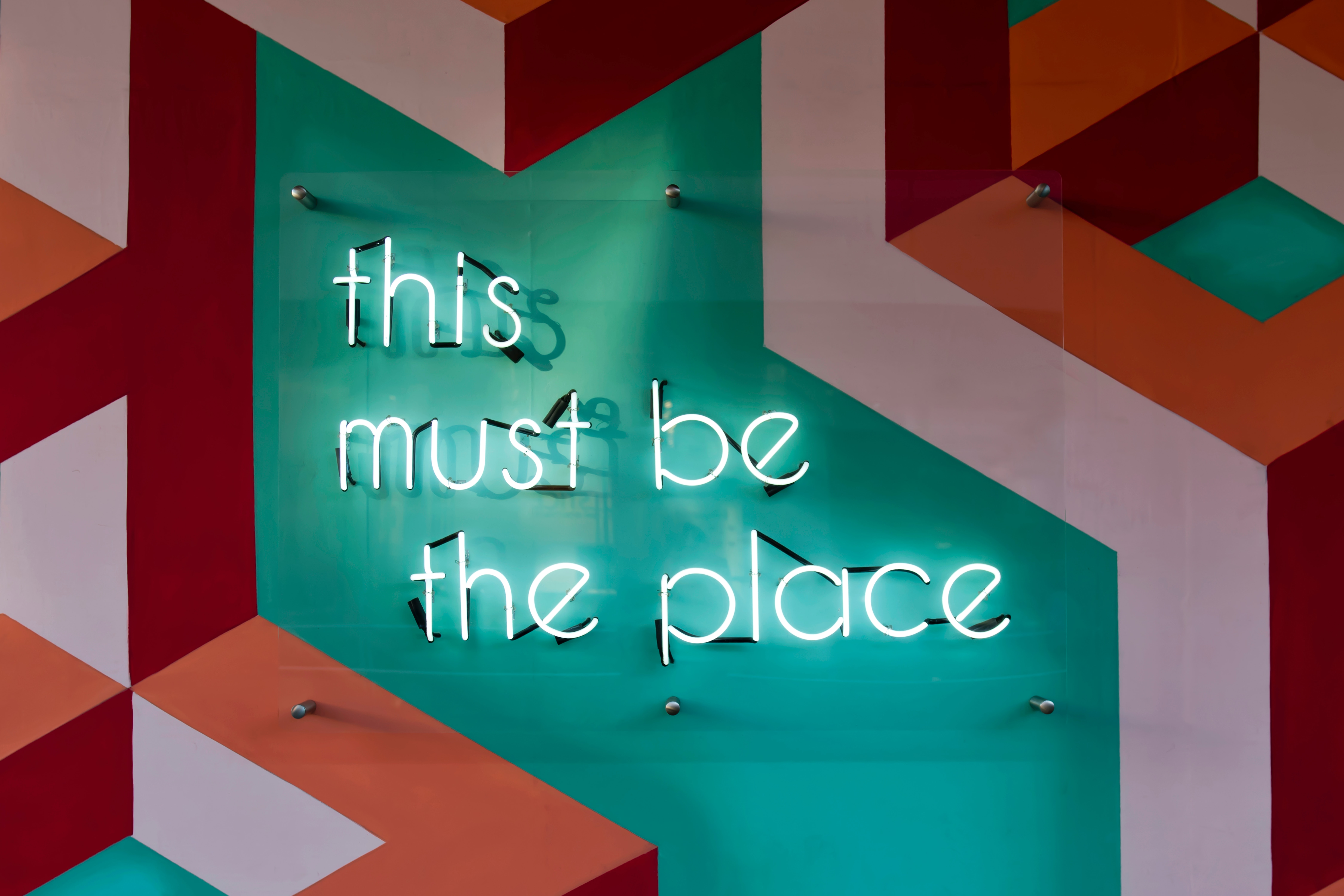
By now, anyone would be shocked to hear that someone has never attended a virtual meeting or event. But, we might not be so shocked to hear that “it was just ok†or “that could’ve been said in an emailâ€. We are finding that after months of moving events online, some are struggling to find ways to keep their content fresh and provide decent value to the attendees. It may require some out-of-the-norm thinking, but with proper use of technology and incorporation of quality education, a desirable and successful outcome is possible.Â
Technology is more important now than ever for hosting engaging meetings and events. However, we are finding that even the best of the best blue light blocking glasses can’t prevent “screen exhaustion†and “zoom fatigueâ€. It can be challenging to even know where to start when beginning to plan, so start with an informative and user-friendly event website. The event website should be a resource for potential attendees to learn about the event and register. The website can include the event itinerary and communicate to potential participants the value in attending the virtual event.Â
Pro tip for standing out: Be concise with the information on your website registration page. Someone should be able to figure out if this is a virtual meeting or event they want to attend within the first 60 seconds on your page. If your website is top notch, people will associate that with how your event will go.
Gaining participant interest and registration is an important first step, but keeping participants engaged with the use of technology once the event starts is even more important. So, sure the event team knows how to effectively use the technology. And if they don’t, hire someone! Nobody wants to join a virtual event and have to deal with the infamous “technical difficultiesâ€.
Pro tip for standing out: Make sure that there is powerful WiFi wherever the meeting, event, or presenter is streaming from. Although it would be nice in our personal lives to have a mute button, you don’t want a presenter’s mouth moving with the words lagging 2 seconds behind.
There are many new tools to provide a more “real†virtual experience. One of these being virtual reality. While this concept seems new to many of us, taking advantage of VR is not as difficult as it may seem. Give your attendees a tour of a museum or gamify a trade show floor using software. Take VR to another level by having event attendees create an avatar for themself that can walk around an event venue virtually to network or choose different breakout sessions they may be interested in.
Pro tip for standing out: Research new softwares or ways of live streaming. A screen share, although effective, is not always exciting anymore.
Since moving meetings and events online, it is a lot easier for an attendee to get up and walk away, or start working on something else. The point of your virtual meeting or event should not be to provide background noise to someone’s lunch hour. If that was true, our industry would be trending on Spotify Podcasts. Ultimately, you want engaged attendees that are learning something. If they feel as if they didn’t gain valuable knowledge, they will likely not be interested in attending future events with you. Try partnering with an educational institution or a highly valuable principal in the industry to add credibility to the event.
Pro tip for standing out: Not only does your educational speaker affect the quality of the event, but also the uniqueness of the content they share. People want solutions without having to read between the lines. Find someone who is able to speak on a different angle than attendees have maybe heard before.
Written By: Kelly Pawlak
Three Ways to Host Safe Events Now
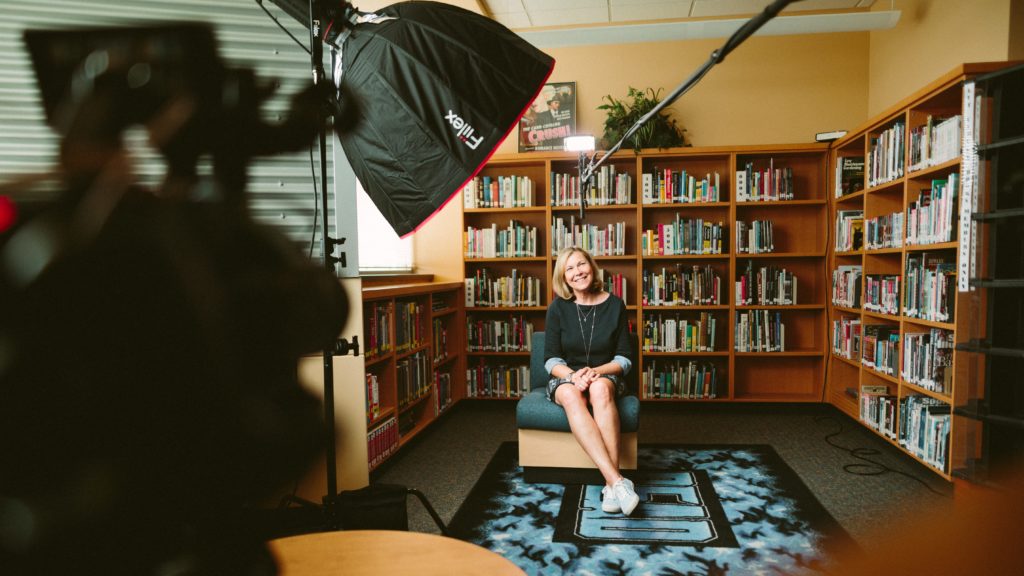
The events world has been shaken up for quite a bit now. As the industry progresses through the phases of reopening, there has been one common denominator: safety first...and that will likely be the new standard. Through remaining connected with our industry peers, we found that what almost everyone wants to know is “Of all the work-arounds due to COVID-19, which ones are here to stay forever?â€. Until the future of events unravels, here are three ways you can host an event now without compromising the safety of your stakeholders.
1. Try out a hybrid event
While virtual events aren’t going away anytime soon, a hybrid event might be the next stepping stone to ease people back into in-person events. Cannonballing into the pool of pre-COVID events might not set you up for success. Instead, you may find that doing a hybrid event, partially live and partially virtual, is a great way to dip your toes in. For instance, try having your presenter(s) broadcast live at a venue, yet keep attendee participation virtual.
At Virtual Planner Master Class, broadcasted live from The Old Post Office, the Ateema team hosted their event at a venue, just as one would for an in-person event. The main difference was that the presenters were speaking to the attendees through a room equipped with A/V broadcasting capabilities and their outfits included a mask as the finishing touch instead of a name badge. What didn’t change was the wow factor. Jamie Sowski, Marketing & Events Manager for The Old Post Office, was able to have a video production team pre-record their gorgeous and historic event space, play that video during the broadcast, and do a live voice-over just as if she was actually walking potential clients through the venue.
2. Think unconventionally when working with vendors
Okay, so you may not want to have a medieval-times-feast-style meal for safety reasons. However, that doesn’t mean you have to rule out catering. Whether your event is hybrid or strictly online, catering companies have plenty of creative ways for your attendees to indulge while also keeping them safe.
For virtual events, consider having boxed meals or DIY cooking kits delivered to attendees’ homes. This way, you are bringing the “IRL†factor while eliminating the potential for others (not equipped with PPE and lawfully required to meet sanitization standards) to come in contact with the food. To turn it into a hybrid event, consider broadcasting from a kitchen or bar with a live demo for the attendees to follow along with their goodie boxes delivered prior to the event.
Blue Plate Catering hosted a happy hour after Virtual Planner Master Class where they showcased their deliverable, seasonal offerings, and encouraged attendees to GYOB (grab your own beverage) while watching a mixologist demo their “sealed-with-safety†margaritas.
3. Design strategically for maximum comfort
In addition to the type of hybrid event we mentioned earlier, there are other ways to host a hybrid event. One of those ways is to allow a limited number of attendees to experience the event live with the event host and presenter(s). But before you go crazy with sending out these VIP invites, you need to envision the event design and event flow for maximum safety and respectively, maximum comfort.
So, how can you grab a venue that permits the ability to socially distance with ease? An answer to this question is outdoor events...bring your guests outside to the openness and fresh air. Or, opt for a large venue. Long gone are the days when a venue says “we've squeezed 100 people in a 500-square-foot room beforeâ€. Rooms with spacious floor plans are going to be better received by skeptical guests. It creates a feeling that their personal space is not threatened.
Also, give every guest a way to display their level of comfortability without the awkward do-we-hug-or-do-I-just-wave-hello moment. Support a local printer and create stickers with comical sayings like “Can’t Touch This†or “Free High Fivesâ€. When you create stickers for your attendees, don’t forget stickers for the floor...yes, you read that correctly. Having reminders on the floor that show people which way to walk and how far apart to stand is a great way to plan safe event flow and spatial comfort.
Written By: Emma McVady
Ideas to Improve Virtual Attendee Engagement
Now more than ever, it is vital to understand how to make virtual events more appealing to stakeholders, sponsors, and attendees. A recent poll from a Virtual Planner Master Class showed that 60% of planners are considering shifting their events to virtual or hybrid. With so many businesses temporarily closing or shifting to a remote workforce, there is a demand for fresh ideas that can take ordinary online events to interactive digital experiences for your attendees. Here are some ideas that can paint your virtual event red against a white background.
Don?t Lose Sight of the Physical Aspect
Tangibility is not the first thing that comes to mind when you hear the word ?virtual? ? even more reason to utilize it. If you can manage to pull in a physical aspect, you will set your event apart from the rest.
Looking at a screen can be extremely 2 dimensional. To bring in that 3D element, you?ll have to get creative. If you are a baker, you may consider delivering a cookie kit to those who register for your cookie making tutorial event. That way, your consumers can physically follow along. Or, if you?re a librarian, you may consider delivering a physical copy of a book to your event goers, so your consumers can hold the book.?
There may not be many cookie-bakers and librarians reading this, but the same rule applies for your business?s virtual event. Give a tangible taste of your product or message. This creates value for consumers and adds an interactive element to your next virtual experience.??
Master Class tip: At the last virtual event we hosted, we delivered a tin of Garrett?s Popcorn to each panelist, which offered a positive incentive to the panelists while on the Zoom webinar.
Include Positive Incentives
Think about when you were in high school, around homecoming (I know, bear with me). You may have had spirit days, where you all wore hats to school or fashioned a crazy hairdo. It is likely that this made you more excited to come to school. Well, the same rule applies to virtual events.
Adding a twist to your event, like a virtual happy hour, gives people something to be more excited about. Therefore, people are more likely to express excitement for your event ? just like high school spirit week made you excited to come to school.
It would look something like this: you put together your event, you inform consumers that by attending your event, they will have both the event content and the positive incentive of your choice to look forward to. All of the people who tend to flake may say, ?hmmm? I don?t know if I?m up for it, but a virtual happy hour afterward is pretty cool ? can?t miss that. Alright, I?m in!?
Master Class tip: In order to encourage people in the industry to stay connected at this time, we?ve been offering an optional virtual happy hour at the end of each online event. We normally host monthly networking events and meet-ups, so it makes sense for us to continue to connect people virtually even during this time.?
Broadcasting a Virtual Experience?
Virtual experiences, like cooking demonstrations, comedy lessons, and cocktail demonstrations are all great tools to get your audience interested in attending your virtual event.?
Similar to positive incentives, virtual experiences add excitement and value to the event. With something like a virtual happy hour, the incentive is simply having fun. However, adding a virtual experience or lesson entices people by giving them the opportunity to learn something.?
You can market your virtual event by letting prospective attendees know that they will have knowledge of something new to take away afterward.?
Master Class tip: Master Class Tip: At our Virtual Planner Master Class, we partnered with Live Art International to create a unique virtual experience with DIY Wine Glass Painting Kits. Two days before the event, early registrants received a wine glass in the mail to self-decorate, along with painting materials and an instruction guide. Then, we encouraged everyone to bring their glass to our virtual happy hour. To take things to another level, we gathered selfies of everyone with their wine glasses and put them into a collage to be shared on social media.?
Use Small Group Interaction as a Deliverable
What sets an event apart from a lecture? The answer is simple: interaction. It is important to include small-group opportunities in your virtual event for consumers to see value in it. Speaking to other like-minded individuals makes consumers feel that they are a part of something, and that ?something? is your brand.
For optimal engagement, it is important to preload poll questions to captivate your audience and gather feedback. If you are looking to gather any poll feedback, you should launch the poll with at least 5 minutes of programming left.
Small groups will give your event the value of socialization, brainstorming, discussing, and more. This value is the perfect deliverable to market to consumers. Utilizing Zoom breakout rooms shifts the event from passive to active. Make it known that your event is different because it is not just a lecture, but a collaborative colloquy.
Master Class tip: To encourage small group interaction at our virtual events, we break the group into multiple smaller groups. We shuffle people around intermittently to offer maximum networking opportunities. Our timing formula changes based on the content and audience of the event, but we found moving people around keeps them engaged for much longer than a presentation format does.
Author: Emma McVady, Ateema
5 Trends To Think About While Pivoting Back to Live Events
As companies try to resume conducting business under the new normal, it will be a learning curve for all including event planners, hosts, vendors, venues, and attendees. Adjusting to the new norm post-COVID-19, those that are able to be flexible, adaptable and can pivot during these challenging times could be the most successful!  Keeping an open mind to new ways of hosting events which includes human interaction can be very advantageous as the industry plans for live events. Here’s our projections for what trends we might see when we start meeting in person again...
Never Enough Precaution
Besides checking your typical details with vendors, suppliers, and the venue, safety and security processes will now be incorporated. These safety protocols should be communicated to your guests to ensure them that their health and safety are at the forefront. It is now standard protocol to have a COVID-19 event checklist that includes temperature checking of employees and guests, in addition to requiring all to wear a face covering. There will be a dramatic difference with how everyone interfaces with each other as well. Long gone are the days where greeters are handing out materials such as maps and agendas as events will establish more self-service features for their participants. In addition, hand sanitizer will be more readily available and very much appreciated. Guests might be limited to bringing their belongings as ensuring the safety for both your guests and employees will go a long way. 
Innovative Food Options
It is important that participants feel all safety precautions were considered when it comes to the food being served at the events. As part of taking precautionary measures, buffets may not be a popular option to avoid serving utensils having multiple touches and to avoid people standing in lines. But don’t worry, planners are looking at creative meal options. Boxed lunches or pre-packed grab and go individual meals will be offered as well as seated meals. Planners will also be thinking outside of the box such as leveraging favorite food trucks or catering from your popular restaurants with carry out style options to still make it an enjoyable event. Although seating may be more restricted in numbers at a table, who says you can’t have a great experience with a smaller intimate group which may encourage better networking and connections?
Behind-the-Scenes Workers Now in the Spotlight
Pre-COVID 19, it was all about seamlessly transitioning the events with flipping the rooms quickly to avoid any type of event distractions. Post COVID-19 attendees might want the staff to be more visible. Seeing them frequently wiping down high touched spaces and continuous cleaning will now be more than welcomed. As well, I’m sure attendees won’t mind the cleaning crew to spend a little extra time in between room flips.
Empty Rooms a Good Thing Now?
In order for participants to feel comfortable to be in the same room with others while allowing the appropriate social distance, it is now acceptable and expected that rooms are not filled to capacity to reassure their guests. Brainstorming possible event room layouts with bigger rooms for less people and to how to space out the furniture will be key. Foot traffic directions that include warning signs that show “high traffic†or “high touch areas†will be part of the event set up too. Lastly, event planners will need to consider the staff’s ability to wipe down as frequently as possible based on venue layout.
Hybrid! Hybrid! Hybrid!
As we adjust to our new norm, hybrid events should be considered as an option. Hybrid events combine live people with virtual attendees and with budgets that may be more limited to hosting smaller groups this still allows for that personal connection. Something else to consider is combining live presentations and entertainment broadcasted from different rooms as that will help avoid having too many people in one room at a time. An additional benefit to hosting hybrid events, is the ability to be more flexible because the resources that you will be depending on will be more limited such as security, staff, catering, PPE, cleaning supplies, etc. Hybrid is a great alternative option for those who may still fear gathering with other people but also an opportunity to keep your event participation rate high.
How to Craft Your New Site Visit Checklist Post COVID-19
Cleanliness 
As businesses slowly begin to reopen, it will be important as you plan your events to consider the health and safety of the guests. At this point, there should be more evident measures that the venue has or is doing to ensure the health or safety of both their staff and guests. As you complete your site visits, evaluating the protocols they have put in place such as cleanliness of the bathroom should be considered. Ask them, how often will the bathrooms be cleaned and disinfected during your event? In addition, you should evaluate the safety protocols for their staffers, will they be wearing masks now as they pass around appetizers and interface with the guests? What are they doing to take precautions with food preparation  and have serving methods changed, we already know buffets are a thing of the past - will individual food containers be a thing of the future?
Social Distancing
Will events be limited to 25% capacity, 50%, or are we concerned at all? Other things to consider is venue space and options to accommodate social distancing requirements. Does the venue have outdoor space to use, how tall are the ceilings in the room(s), how updated is the ventilation system and air filters, can we use multiple rooms to allow social distancing. How will the seating or furniture arrangements be changed to limit the amount of guests from being in too close proximity of each other. Will attendees be required to wear masks and what protocols are in place to encourage attendees to self monitor themselves prior attending the event and what is the protocol on how to handle anyone that experiences symptoms during the event.
Tech capabilities
Every planner looks for in-house A/V capabilities when on their site visit, but what we should be looking for now is built-in cameras for broadcasting our event online. As more and more businesses open their doors, we need to remember that not everyone will feel comfortable going back out right away. People will come back in waves and it will depend heavily on the individual generation, personality, location, upbringing, and their overall comfort level with COVID-19. Providing alternate solutions such as hybrid events should be kept in mind thus the importance of venue tech capabilities. To increase a good turnout technological solutions will allow planners to incorporate both live and virtual events.
In-House or Preferred Vendors
With any venue that we are selecting for our next in-person event, we must find out if they use in-house catering and A/V, or do they outsource to their list of preferred vendors. One would hope that  the  venue will try to extend whatever new health & safety policies and set the expectations with their preferred partners. While leveraging in-house services may be more attractive over having several vendors in play to limit the possible transmission of coronavirus it is important that your client feels confident with the health and safety measures that are put in place for all resources used. Some venues will be required to utilize union resources so it will be important to confirm safety measures are put in place for any vendor whether it is onsite resources, offsite resources and union resources.
Location
As the largest cities in America are still on lockdown, planners are looking to other less populated destinations for their next event. Not only will they be opening earlier, but it will be easier to incorporate social distancing in a more spread out area than your normal big city such as New York. It will be important to ask your venue what protocols they have in place for things such as public elevator access. Can the event planner incorporate any regulation on the number of people in the elevator at a time? Will the area be designated just for event participants or will multiple events be taken place and/or open to the public. Is your event in a private or semi-private space will be more important than ever.  
How to Adjust Live Event Content for Virtual Events
Sometimes the unthinkable happens ? a disaster, a cancellation, an instance out of our control. As we?re seeing now, that can have a big impact on what we do as event professionals and how we gather as people to learn, network, and engage.
But with a switch in strategic thinking and the right partners for content and technology, you can pull off a virtual event that is every bit as exciting as your in-person plan.
Embrace the new opportunities
As you jump into virtual events, know that your virtual event strategy is not going to be 100% the same as your live event strategy. Adjusting your plan for virtual events opens up new possibilities that you must consider before moving forward.
First and foremost, revisit your goals and priorities. How do they need to change with a virtual event? Can they be expanded? Does anything need to switch out? Capture all of this information so that it?s handy to reference as you revisit decisions.
Another thing to consider ? going digital can mean getting even more data from your event. More insights means more ways you can show value, so it?s important to align ahead of time on the right metrics for your team to track.
Add to your audience
Once your goals are firmly in place, think about your audience ? that target is highly likely to change when you?re putting on a virtual event, simply because you have the ability to expand your reach beyond the confines of geography. And that expanded audience isn?t just about reach ? it also allows for more targeted, personalized messaging.
Consider adding other personas, industries, or more to your marketing list to expand that net even farther. Community is more important than ever before, and yours may be wider than you once thought.
Inject some personality
First and foremost, having a great moderator or emcee is critical for translating live events to the virtual space. It can be too easy for things to go off the rails, especially in a new format ? let alone having to work around potential connectivity issues, technology glitches, or any other surprises. That?s why having someone calm, engaging, and knowledgeable steering the conversations and providing transitions between elements is so important.
They can be the central guiding voice throughout the event that gives out important information, introduces new speakers, makes announcements, and more. Having the perfect personality in charge helps bring life to your event, helping attendees get more engaged and moving away from a scripted look and feel.
Break things up
You might think that having a captive virtual audience is the perfect opportunity to dive into a topic for a few hours at a time ? but think again. It?s even more vital to break up virtual event content into manageable chunks so that you don?t lose attendee attention and participation.
Ten to 15 minute sections are suggested for ideal content consumption. Between those sections, the content can be broken up by interactive moments, like taking some questions, leveraging a poll, or drawing for a prize. This helps attendees fully digest the content without feeling overwhelmed from a distance. Opportunities for networking can also be added between sessions to keep people engaged with one another as well as the content.
We highly recommend using a mix of pre-recorded videos along with live streaming for all virtual events. This gives you more control over your content before the event, allowing for editing, reshooting, or redesigning. This is a similar approach to successful television broadcasting. Then, you can take advantage of the live platform to generate great conversations and interaction with attendees.
Get engaged
Virtual events can be just as rich with inspiration and education as a face-to-face experience, but when people are working from their own spaces, it can be harder than ever to keep distractions to a minimum.
That?s why adding interactivity to virtual events is an absolute must to foster engagement and keep attention. There are lots of options that you can deploy in a way that makes the most sense for your audience, format, and content:
- Conversational formats instead of rote webinar standards can help attendees feel more relaxed and engaged during sessions, especially when you have a great moderator to keep things moving along and guests who add not just expertise, but energy to the event.
- Virtual lobbies not only help you with crowd control while you make last-minute adjustments, but they give attendees a valuable moment to chat and introduce themselves.
- Virtual product showcases can take the place of some of what attendees are used to seeing on the show floor. Think outside the box while also thinking about what tech attendees typically have at home. This can work for things like product walkthroughs, augmented reality experiences, and more.
- Feedback and Q&A sessions are the better way to handle audience interaction during a virtual event. Having these features built into your platform helps you manage the information flow, and you can pivot if necessary based on the feedback you receive. This also boosts engagement and helps ensure that conversations are a two-way street. The more attendees interact and engage, the more value they find in your event.
- Polls and surveys help break up your content flow and provide a moment of breathing room for presenters while also getting valuable feedback straight from the audience. That data can provide interesting insights during and after presentations, as well as a read on the room to see who?s actually engaging.
- Contest or raffle elements built into your event add some fun and excitement while working as an additional incentive to keep people engaged with your content. They could even be a part of a virtual sponsorship opportunity!
Connect and curate
When events are virtual, it?s that much harder for attendees to network among the group and meet with like-minded individuals. That?s part of what makes live events so special ? and something we don?t want to lose.
Personalization and personal connection, wherever we can create it, is a crucial way to keep people engaged and help a virtual event feel as genuine as a live experience.
Some solutions have features that allow you to split a virtual meeting into smaller groups, like breakout sessions. This can be utilized to create focused discussions around different questions, areas of expertise, interests, and more.
Having not just speakers, but attendees share short bios and connect via channels like LinkedIn helps people get a sense of who?s on the other side of the screen. And creating groups on Facebook or Slack channels focused on the event and specific topics is a great way to keep people in touch for post-event communications, discussions, and more.
By keeping these tips in mind, as well as working with a great partner that can help you with technology infrastructure, strategy, marketing, and more, you can successfully transition your live event to a virtual one without missing a beat.
Article By: LOUIS LAYTON
Source: Freeman
10 Event Trends for 2020
New decade, new trends! From innovative technologies to catering to a greater audience, the meeting and event planning space is rife with new ways to stand out. Here are 10 trends to keep an eye out for in 2020:
Innovative Eventtech
New registration tools are making events easier and more manageable onsite. Companies like ExpoPass eliminate the frustration of scanning tickets, looking up registration accounts, and even printing name badges.
App Adoption
App usage for events has significantly increase in the last year, and many event professionals see apps as an added value to the event. Having one place to provide site maps, distributed information, FAQs, and more makes navigating the event easier for both attendees and managers alike.
Offering a Tourist Attraction
Expecting out-of-towners to attend your event - Offering an offsite activity, day trip, or unique outing is attractive to registrants and will keep them coming back year after year.
Asking for Feedback
Gone are the days of a paper survey that may or may not get tossed in the trash. Digital post-event surveys through an event app or via email help planners increase feedback from both attendees and sponsors and make it easier to calculate analytics and find trends.
Charity Components
Creating an environment that unifies attendees and sponsors is key in making a memorable experience and more and more planners are implementing a charitable component to the events. Donation drives, offsite volunteering, and trips to witness local culture are more prominent.
Offering Exclusivity
Unique venues can make or break an event, and giving attendees an experience through location is on the 2020 horizon. Luxury resorts, cruise ships, and festival-style events are great ways to make your event a must.
Be Sustainable
The well-being of the environment is top of mind for 2020, and event planners will be making bigger strides in making their events more sustainable. Planners are considering sustainable transportation, recycling options, digital forms of paperwork, solar energy and more.
Make Decor Part Of the Interaction
Key placement of decor and furniture can actually help facilitate mingling and promote the ultimate goal of the event - networking and interaction! Filling large spaces with couches, tables, and even interactive games will be key to the ultimate comfort level of guests.
Cool Eats and Treats
Who doesn't love a fun ice luge or a beautiful carving station - Creating an "exhibit" with the food is a great way to add visual excitement to something you'd already have on site anyway. Interactive food stations like food trucks or build-your-own bars will also be making a splash in 2020.
Make It Personal
A draw for many is the locale itself and ensuring that your attendees have a taste of local culture is super-important. Sourcing local vendors for decor, transportation, and venue space can make all the difference in your event standing out, as well as local menus (Are you hosting an event in Chicago - Maybe one meal consists of local favorites like deep dish pizza and Italian beef!)
3 Tips for Maximizing Procurement and Vendor Relationships
The first step in any great event is, well, finding a place to host it! Any good event planner knows that finding the perfect venue and developing a relationship with the venue - s sales team, marketing department, and catering team is imperative to the outcome of the event. We spoke to three successful Chicagoland event planners at PlannerPalooza! and got their best tips for maximizing procurement strategies and vendor relationships.
Details, Details, Details!
Leave no stone unturned - a detailed RFP is your friend says Bailey Shultz, Account Manager for Sourcing at NHS Global Events. Shultz says that a detailed RFP is helpful for a few reasons; in a saturated market, distinguishing your business from others is necessary, too few details make you a less desirable candidate and will not elicit a response, and small details help to determine an accurate budget. Jackie White, Director of Events & Conference Services at Illinois Institute of Technology, says that identifying and including all of the - what ifs - and potential acts of God that could take place in a particular city will help both parties build a strong foundation ahead of an event.
Make It Personal
What better way to build a relationship with a venue than to actually get to know the people behind the title - White says that taking the time to get to know a vendor on a personal level has helped her to build lasting and mutually beneficial professional relationships. Perhaps a sales manager at a catering company just got married or has a birthday coming up; a card in the mail or a small gift is a meaningful and personal touch that will help you remain top of mind in the future. Jay Weidner, Managing Partner at On The Scene noted that taking the extra step in finding what the client truly wants and identifying their objectives will show that you - ve done the due diligence in ensuring the event is successful. Weidner also said that you may find that the client is not always the stakeholder and their ultimate objectives may be different. Get to know the people you - re working with on a more personal level to better define their goals!
Money matters in the event industry! Vendor relationships rely heavily on efficient spending and saving. Weidner says that it - s now more important than ever to find the main items that clients are NOT making money on, and find a workaround to monetize those. Maybe they aren - t making money off of name badges or transportation; a sponsor can offset those costs and either save the client money with in-kind sponsorships or earn money with a paid sponsorship. White suggests finding out if the sales team of one of your vendors is trying to reach a bonus or a perk; if they are, work out a mutually beneficial contract that helps save your client some money and the sales person reach their quota.
Sources: -
Jackie White, Director of Events & Conference Services
Illinois Institute of Technology
Jay Weidner, Managing Partner
On The Scene
Baily Shultz, Account Manager - Sourcing
NHS Global Events
5 Ways Planners Are Elevating The Overall Event Experience

For years the event standard included a beige room with beige furniture, white linens, a plated chicken dish, and speaker after speaker at a podium. While the element of consistency held up for quite some time, the past few years have pushed meeting and event planners to think outside the box when it comes to creating an innovative event experience.
At a recent Chicago Planner Master Class, event innovation was heavily discussed by more than 75 experienced meeting and event planners during roundtable discussions. Here are five exciting ways that meeting and event planners are getting even more creative with their event experience:
1) Better Food, Better Event
Remember that plated chicken dish? According to our discussion groups, it's done. Meeting attendees are now expecting more for their time and their registration fee and it starts with the food. Our planners have integrated more local cuisine into their event menus; if the event takes place in Chicago, deep-dish pizza, cheesecake, and a sizzling steak can be part of that. Even how food is being served is changing and becoming an experience rather than a logistic; food trucks, 'Instagrammable' platings, build-your-own experiences, and even classes where attendees learn how to cook a local meal have taken over as popular, memorable event meals.
2) More Things To Do - Besides Sitting in a Chair
Gathering your event attendees into a sterile-looking room to listen to a multitude of speakers makes for a pretty stagnant event. The meeting and event planners we talked to have been using on-site activations, games, and great keynote speakers to give their attendees something engaging and memorable during the event. One planner hosted a 'Board Member Roast' as part of their welcome session to break the ice and get the event started off on a fun - and hilarious - note. Another planner set up a golf simulator outside of the meeting rooms so attendees could compete with one another during breaks; at the end of the event, the winner received a prize. One planner found that their attendance was higher when they announced that their keynote speaker was an entertainer completely unrelated to the topic of the event.
3) Innovation Starts At Registration
According to the meeting and event planners at the Chicago Planner Master Class, sometimes innovation doesn't mean lots of costly bells and whistles throughout the duration of the event. For many, the art of innovation starts right at the registration table. Oftentimes, the registration process (and the line!) is daunting, boring, and inefficient. Creating a quick and streamlined process kicks off the event in a positive note, especially in the eyes of attendees. One planner mentioned having monitors along the registration queue that played short, dynamic videos about what they could expect throughout the event - a move that was entertaining enough to make the wait seem much shorter while driving excitement and anticipation for the event ahead. Another planner had a team of personnel hand out water and snacks to those waiting in line which offered a personal touch and a way for attendees to get to know the facilitators.
4) Experiences Over "Stuff"
In an age where social media reigns supreme, people are always looking for exciting things to document. Meeting and event planners are leaning more towards fun experiences rather than things when it comes to creating an innovative event. What does this mean exactly? The planners we spoke to have steered away from giveaways like water bottles, T-shirts, and pens, in favor of off-site experiences like local shows, tours of the host city, and a casual post-work activity like renting out a bowling alley or going to a game.
5) Keep The Event Top Of Mind After Adjournment
An innovative event experience shouldn't stop at the close of a door and a flight home. Our planners agreed that some of their most successful events (determined by how many guests are repeat attendees) were ones where a concerted effort was made to maintain communication post-event. Sending out post-event thank you emails, following up with phone calls over the next week, and administering feedback surveys to let guests voice their opinions are all easy ways to make attendees feel valued. According to the planners we spoke to, attendees who felt like their time and opinions were valued will keep coming back because they feel like they played a role in the success of the event.


